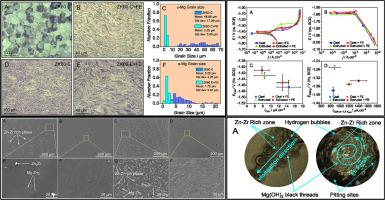当前位置:
X-MOL 学术
›
J. Magnes. Alloys
›
论文详情
Our official English website, www.x-mol.net, welcomes your
feedback! (Note: you will need to create a separate account there.)
Effect of corrosion behavior of cast and extruded ZK60 magnesium alloys processed via friction extrusion
Journal of Magnesium and Alloys ( IF 15.8 ) Pub Date : 2024-10-15 , DOI: 10.1016/j.jma.2024.09.015 A. Sharma, V. Beura, D. Zhang, J. Darsell, S. Niverty, V. Prabhakaran, N. Overman, D.R. Herling, V. Joshi, K. Solanki
Journal of Magnesium and Alloys ( IF 15.8 ) Pub Date : 2024-10-15 , DOI: 10.1016/j.jma.2024.09.015 A. Sharma, V. Beura, D. Zhang, J. Darsell, S. Niverty, V. Prabhakaran, N. Overman, D.R. Herling, V. Joshi, K. Solanki

|
The increasing demand for high-strength, corrosion-resistant magnesium alloys in transportation has led to the development of new processing techniques. In this work, cast and extruded ZK60 magnesium alloys were processed using the innovative solid-phase process, Friction Extrusion (FE). The microstructure was analyzed using Scanning Electron Microscopy (SEM), and Energy Dispersive Spectroscopy (EDS), showing a marked reduction in grain size, uniform solute distribution (Zn and Zr), and second phases after FE processing. Moreover, optical micrographs and Electron Backscatter Diffraction (EBSD) were employed to further evaluate the alloy microstructure. The corrosion resistance and electrochemical behavior were analyzed using potentiodynamic polarization, Scanning Electrochemical Cell Impedance Microscopy (SECCIM), and atomic emission spectroelectrochemistry analysis (AESEC). Time evolution surface imaging and post-corrosion microstructures were also analyzed to support the understanding of underlying corrosion mechanisms. Corrosion initiation and propagation in FE-processed samples followed grain boundary patterns, differing from cast and extruded ZK60 behaviors. Electrochemical measurements and in-situ time-dependent optical imaging demonstrated that FE processing enhanced corrosion potential, reduced corrosion current, and increased cathodic activity. Additionally, FE processing reduced the disparity in pitting potential between cast and extruded samples, resulting in intermediate pitting potentials. Higher Mg and lower Zn dissolution was observed in the lower anodic currents for FE-processed samples. During aggravated anodic current cycles, Mg dissolution equalized, but the Zn/Mg dissolution ratio increased for FE-processed extruded samples, suggesting less cathodic activation and better resistance to further pitting.
中文翻译:

摩擦挤压加工的铸造和挤压 ZK60 镁合金的腐蚀行为影响
运输中对高强度、耐腐蚀镁合金的需求不断增长,这导致了新加工技术的发展。在这项工作中,使用创新的固相工艺摩擦挤压 (FE) 加工铸造和挤压 ZK60 镁合金。使用扫描电子显微镜 (SEM) 和能量色散光谱 (EDS) 分析微观结构,显示 FE 加工后晶粒尺寸明显减小,溶质分布均匀(Zn 和 Zr)和第二相。此外,采用光学显微照片和电子背散射衍射 (EBSD) 进一步评价合金的微观结构。使用电位动力学极化、扫描电化学电池阻抗显微镜 (SECCIM) 和原子发射光谱电化学分析 (AESEC) 分析耐腐蚀性和电化学行为。还分析了时间演变表面成像和腐蚀后微观结构,以支持对潜在腐蚀机制的理解。FE 处理样品中的腐蚀萌生和扩展遵循晶界模式,与铸造和挤压 ZK60 的行为不同。电化学测量和原位时间依赖性光学成像表明,FE 处理增强了腐蚀电位,降低了腐蚀电流,并增加了阴极活性。此外,FE 处理减少了铸造和挤压样品之间点蚀电位的差异,从而产生了中等点蚀电位。对于 FE 处理样品,在较低的阳极电流中观察到较高的 Mg 和较低的 Zn 溶解。 在加剧的阳极电流循环期间,Mg 溶解均衡,但 FE 处理的挤压样品的 Zn/Mg 溶解率增加,表明阴极活化较少,对进一步点蚀的抵抗力更好。
更新日期:2024-10-15
中文翻译:

摩擦挤压加工的铸造和挤压 ZK60 镁合金的腐蚀行为影响
运输中对高强度、耐腐蚀镁合金的需求不断增长,这导致了新加工技术的发展。在这项工作中,使用创新的固相工艺摩擦挤压 (FE) 加工铸造和挤压 ZK60 镁合金。使用扫描电子显微镜 (SEM) 和能量色散光谱 (EDS) 分析微观结构,显示 FE 加工后晶粒尺寸明显减小,溶质分布均匀(Zn 和 Zr)和第二相。此外,采用光学显微照片和电子背散射衍射 (EBSD) 进一步评价合金的微观结构。使用电位动力学极化、扫描电化学电池阻抗显微镜 (SECCIM) 和原子发射光谱电化学分析 (AESEC) 分析耐腐蚀性和电化学行为。还分析了时间演变表面成像和腐蚀后微观结构,以支持对潜在腐蚀机制的理解。FE 处理样品中的腐蚀萌生和扩展遵循晶界模式,与铸造和挤压 ZK60 的行为不同。电化学测量和原位时间依赖性光学成像表明,FE 处理增强了腐蚀电位,降低了腐蚀电流,并增加了阴极活性。此外,FE 处理减少了铸造和挤压样品之间点蚀电位的差异,从而产生了中等点蚀电位。对于 FE 处理样品,在较低的阳极电流中观察到较高的 Mg 和较低的 Zn 溶解。 在加剧的阳极电流循环期间,Mg 溶解均衡,但 FE 处理的挤压样品的 Zn/Mg 溶解率增加,表明阴极活化较少,对进一步点蚀的抵抗力更好。


















































 京公网安备 11010802027423号
京公网安备 11010802027423号